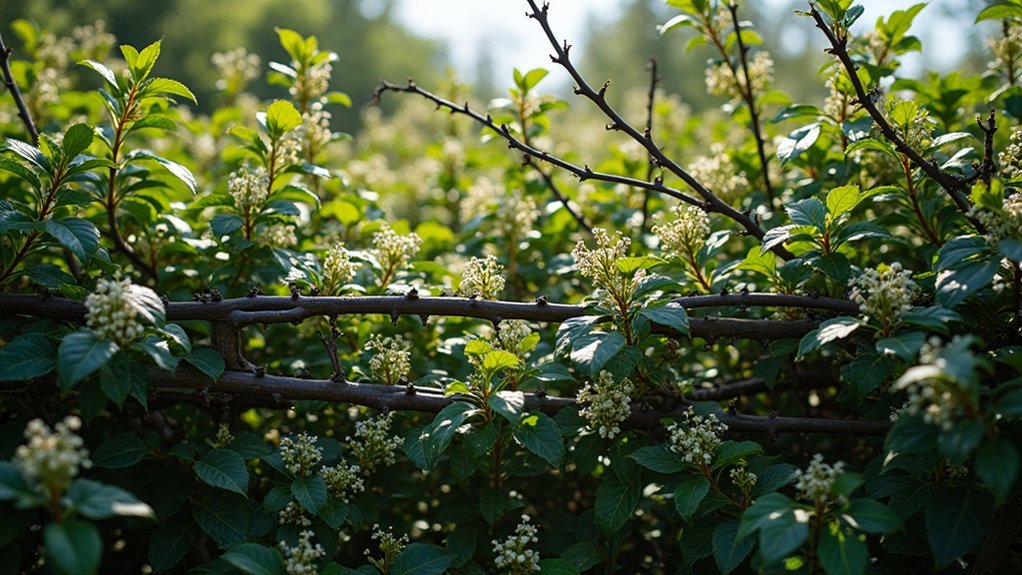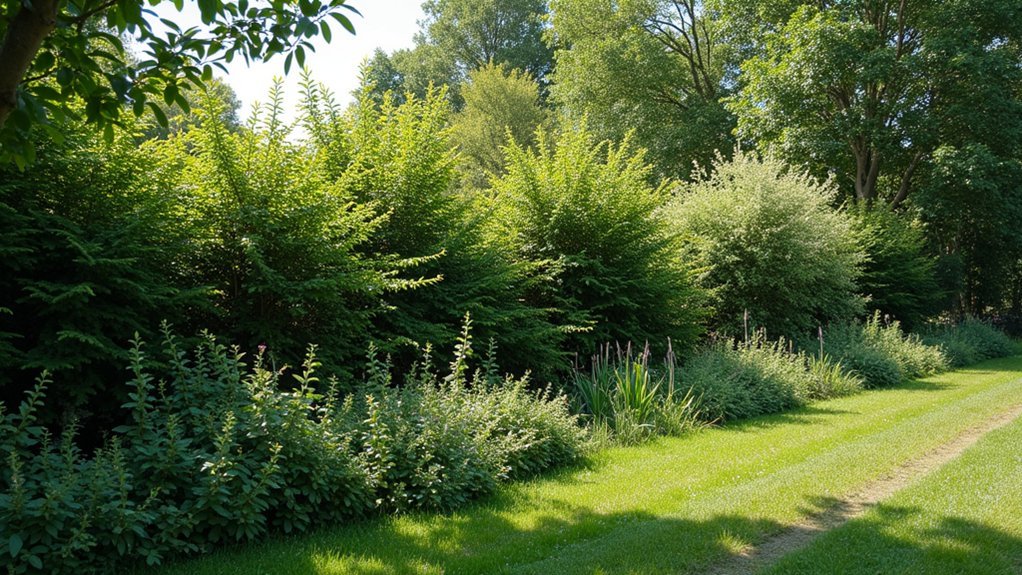For secure, wildlife-friendly boundaries, consider blackthorn for its impenetrable thorny barriers and rapid growth; hawthorn for its balance of beauty and protection with spring blossoms and autumn berries; or mixed species hedges for year-round security with diverse ecological benefits. You’ll create natural boundaries that deter intruders while supporting pollinators, birds, and small mammals. Discover how these living fences can transform your property’s edge into thriving ecosystems with minimal maintenance.
Blackthorn: Nature’s Barbed Security System

A fortress of thorns, the blackthorn (Prunus spinosa) stands as nature’s own security system. You’ll find its dense, impenetrable barriers have protected boundaries for centuries across the UK and northern Europe, effectively deterring both livestock and intruders.
The blackthorn’s formidable defense comes from its sharp thorns and tightly tangled branches that create a physical barrier few would attempt to breach. Growing rapidly at 30-60cm annually and reaching heights of up to 6 meters, it quickly establishes a secure perimeter around your property. The dark grey bark of blackthorn adds to its distinctive appearance, making it both a practical and visually interesting boundary solution.
Nature’s barbed-wire fence grows before your eyes, creating an impenetrable living wall that both protects and impresses.
What makes blackthorn exceptional is its dual-purpose nature. While providing uncompromising security, it also offers spectacular off-white spring flowers, followed by blue-black sloes in autumn.
These seasonal features attract pollinators and birds, turning your security hedge into a thriving wildlife sanctuary.
Hawthorn Hedges: Beautiful Barriers With Protective Thorns
Revered for its versatility and practicality, the hawthorn (Crataegus monogyna) creates a perfect balance between security and natural beauty.
You’ll enjoy its pale green foliage in spring, followed by delicate pink blossoms in May and vibrant red berries come autumn.
The sharp thorns form a formidable barrier against unwanted visitors while providing safe nesting sites for birds.
Your hawthorn hedge will support over 150 insect species and feed numerous birds and mammals through winter with its nutritious berries. The hedge creates an ecological haven with flowers providing essential nectar and pollen for many bee species and other important pollinators.
This fast-growing deciduous shrub thrives in most conditions except boggy areas.
You’ll need regular trimming to maintain its dense structure, but the effort pays off with enhanced privacy, clear boundary marking, and significant ecological benefits including soil stabilization and carbon capture.
Mixed Species Hedges: Layered Defense With Maximum Wildlife Benefits

While hawthorn offers impressive benefits on its own, mixed species hedges take wildlife support to extraordinary heights. By combining native plants, you’ll create a resilient boundary that thrives in local conditions with minimal maintenance.
These layered hedges deliver year-round protection through diverse growth patterns and seasonal interest. You’ll enjoy watching berries, seeds, and colorful foliage attract birds and beneficial insects throughout the seasons. The strategic mix of plants creates an ideal semi-permeable barrier that effectively reduces noise pollution while maintaining airflow.
The ecological benefits are remarkable – mixed hedges prevent soil erosion, store carbon, and create essential wildlife corridors in fragmented landscapes. They serve as natural windbreaks while providing shelter for hedgehogs, field mice, and nesting birds.
For maximum biodiversity, include both deciduous and evergreen species. This combination guarantees continuous cover and food sources, creating a thriving ecosystem right at your property’s edge.
Frequently Asked Questions
How Long Does It Take for a Wildlife Hedge to Establish Security?
Your wildlife hedge will provide basic security within 2-3 years, though it’ll take 5-7 years to reach full maturity. You’ll see faster results if you maintain it properly and choose fast-growing native species.
Can Wildlife-Friendly Hedges Work Alongside Existing Fencing Systems?
Yes, you can pair wildlife-friendly hedges with existing fences for enhanced security. They’ll complement each other as the hedges grow, creating dual barriers while providing habitat. Most native species adapt well alongside fence structures.
How Do Wildlife Hedges Perform in Extreme Weather Conditions?
Wildlife hedges excel in extreme weather. You’ll find they stabilize soil during floods, provide windbreaks in storms, and maintain wildlife shelter year-round. Their flexible stems, deep roots, and diverse structures help them recover quickly after damage.
What Permissions Are Needed for Planting Boundary Hedges?
You’ll need local zoning permits, property boundary verification, and environmental clearances. Check for utility line restrictions, HOA approvals, and conservation area permits before planting. Don’t forget to consult your neighbors too.
How Do Wildlife Hedges Affect Property Insurance or Security Ratings?
Your wildlife hedges may affect insurance premiums based on perceived wildfire risk, property damage potential, and liability concerns. They’ll impact security ratings depending on height, density, and placement that balances visibility with deterrence.
In Summary
You’ve now discovered three excellent options for creating secure boundaries that also support local wildlife. Whether you choose the fortress-like blackthorn, the ornamental yet defensive hawthorn, or a biodiversity-rich mixed hedge, you’ll enjoy both protection and the satisfaction of providing habitat. By selecting these living barriers, you’re creating sustainable security that benefits your property and the environment for years to come.





Leave a Reply